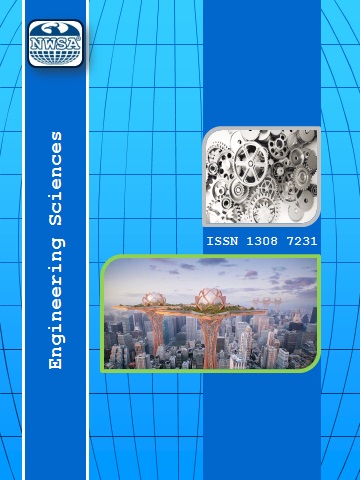References
[1] Nykyri, M., Kärkkäinen, T., Annala, S., and Silventoinen, P., (2022). Review of demand response and energy communities in serious games. Ieee Access, 10:91018-91026. https://doi.org/10.1109/access.2022.3202013.
[2] International Energy Agency, (2023). World Energy Outlook 2023. https://www.iea.org/reports/world-energy-outlook-2023.
[3] Intergovernmental Panel on Climate Change, (2021). Climate Change 2021: The Physical Science Basis. Cambridge University Press.
[4] https://www.ipcc.ch/report/ar6/wg1/IPCC+2IPCC+2IPCC+2
[5] Yadav, D., Garg, R.K., Ahlawat, A., and Chhabra, D., (2020). 3d printable biomaterials for orthopedic implants: solution for sustainable and circular economy. Resources Policy, 68:101767. https://doi.org/10.1016/j.resourpol.2020.101767
[6] Kumar, R., Lamba, R., Maduabuchi, C., Vashishtha, M., and Upadhyaya, S., (2022). Solar energy conversion using a thermoelectric generator with conical frustum shaped pins https://doi.org/10.46855/energy-proceedings-9222.
[7] Kabir, E., Kumar, P., Kumar, S., Adelodun, A.A., and Kim, K.H., (2018). Solar energy: Potential and future prospects. Renewable and Sustainable Energy Reviews, 82:894900. https://doi.org/10.1016/j.rser.2017.09.094.
[8] International Energy Agency, (2022). Renewables 2022: Executive Summary. https://www.iea.org/reports/renewables-2022/executive-summaryIEA
[9] Dorel, S., Osman, M., Strejoiu, C., and Lazaroiu, G., (2023). Exploring optimal charging strategies for off-grid solar photovoltaic systems: a comparative study on battery storage techniques. Batteries, 9(9):470. https://doi.org/10.3390/batteries9090470.
[10] Hijazi, Z. and Hong, J., (2024). Optimal operation of residential battery energy storage systems under covid-19 load changes. Energies, 17(6):1420. https://doi.org/10.3390/en17061420.
[11] Salih, H., Ghazi, M., and Aljanabi, M., (2023). Implementing an automated inventory management system for small and medium-sized enterprises. Iraqi Journal for Computer Science and Mathematics, 238-244. https://doi.org/10.52866/ijcsm.2023.02.02.021.
[12] Sundararaghavan, S., and Baker, E. (2012). Evaluating energy storage technologies for wind power integration. Solar Energy, 86(9), 27072717. https://doi.org/10.1016/j.solener.2012.06.013
[13] Çorapsyz, M. and Kahveci, H., (2022). An overview of frequency-based power split strategies in electric vehicles with battery/supercapacitor hybrid energy storage system. Energy storage, 5(6). https://doi.org/10.1002/est2.429.
[14] Zhao, J., Wang, F., Ruan, Q., Wu, Y., Zhang, B., and Lü, Y., (2024). Hybrid energy storage systems for fast-developing renewable energy plants. Journal of Physics energy, 6(4):042003. https://doi.org/10.1088/2515-7655/ad6fd4.
[15] Smdani, G., Islam, M., Yahaya, A., and Safie, S., (2022). Performance evaluation of advanced energy storage systems: a review. Energy & Environment, 34(4):1094-1141. https://doi.org/10.1177/0958305x221074729.
[16] Xu, H. and Shen, M., (2021). The control of lithium-ion batteries and supercapacitors in hybrid energy storage systems for electric vehicles: a review. International Journal of Energy research, 45(15):20524-20544. https://doi.org/10.1002/er.71509)
[17] Richey, E., Benson, S.M., and Weyant, J.P., (2019). The role of energy storage in deep decarbonization of electricity production. Nature Communications, 10, Article 1. https://doi.org/10.1038/s41467-019-11161-5.
[18] Wang, Y., et al., (2021). A hybrid energy storage system for an electric vehicle and its effectiveness validation. International Journal of Precision Engineering and Manufacturing - Green Technology, 8(6):17391754. https://doi.org/10.1007/s40684-020-00304-5.
[19] Eslami, E. and Kamarposhti, M., (2019). Optimal design of solarwind hybrid system-connected to the network with cost-saving approach and improved network reliability index. Sn Applied Sciences, 1(12). https://doi.org/10.1007/s42452-019-1710-y.
[20] Morais, R., Lopes, M., Bellido, M., Pereira, A., and Branco, D., (2022). Energy storage for photovoltaic power plants: economic analysis for different ion-lithium batteries. Energy storage, 4(6). https://doi.org/10.1002/est2.376.
[21] Shi, Z. and Lu, R., (2024). Study of hybrid energy storage system with energy management for electric vehicle applications. Journal of Physics Conference Series, 2703(1):012013. https://doi.org/10.1088/1742-6596/2703/1/012013.
[22] Yan, D., (2024). Nimoo4/mnco2o4 for high-performance positive electrodes of supercapacitors. Journal of Physics Conference Series, 2783(1):012015. https://doi.org/10.1088/1742-6596/2783/1/012015.
[23] Palandurkar, M., (2019). Fast energy exchange between fixed supercapacitor and on-board supercapacitor. Helix, 9(6), 5784-5789. https://doi.org/10.29042/2019-5784-5789.
[24] Pawar, S., Yu, S., Ju, E., Seo, H., Yeu, J., Kim, J., and Shin, J., (2019). Zinc cobalt layered double hydroxide electrode for high-performance supercapacitor. Applied Science and Convergence Technology, 28(5):164-168. https://doi.org/10.5757/asct.2019.28.5.164.
[25] Yun, T., Kim, D., Kim, S., Kim, I., Hyun, S., and Han, S., (2018). Mulberry paper-based supercapacitor exhibiting high mechanical and chemical toughness for large-scale energy storage applications. Advanced energy Materials, 8(21). https://doi.org/10.1002/aenm.201800064.
[26] Zakeri, B., and Syri, S., (2015). Electrical energy storage systems: A comparative life cycle cost analysis. Renewable and Sustainable Energy Reviews, 42, 569596. https://doi.org/10.1016/j.rser.2014.10.011.
[27] Luo, X., Wang, J., Dooner, M., and Clarke, J., (2015). Overview of current development in electrical energy storage technologies and the application potential in power system operation. Applied Energy, 137, 511536. https://doi.org/10.1016/j.apenergy.2014.09.081.
[28] Miller, J. R., and Simon, P., (2008). Electrochemical capacitors for energy management. Science, 321(5889):651652. https://doi.org/10.1126/science.1158736.
[29] Conway, B.E., (1999). Electrochemical Supercapacitors: Scientific Fundamentals and Technological Applications. Springer.
[30] Dunn, B., Kamath, H., and Tarascon, J.M., (2011). Electrical energy storage for the grid: a battery of choices. Science, 334(6058):928935. https://doi.org/10.1126/science.1212741.
[31] Frackowiak, E. and Béguin, F., (2001). Carbon materials for the electrochemical storage of energy in capacitors. Carbon, 39(6):937950. https://doi.org/10.1016/S0008-6223(00)00183-4.
[32] Burke, A.F., (2000). Ultracapacitors: why, how, and where is the technology. Journal of Power Sources, 91(1):3750. https://doi.org/10.1016/S0378-7753(00)00485-7.
[33] Jossen, A., (2006). Fundamentals of battery dynamics. Journal of Power Sources, 154(2):530-538. https://doi.org/10.1016/j.jpowsour.2005.10.041.
[34] Zhang, L.L., and Zhao, X.S., (2009). Carbon-based materials as supercapacitor electrodes. Chemical Society Reviews, 38(9):25202531. https://doi.org/10.1039/B815003J.
[35] May, G.J., Davidson, A., and Monahov, B., (2018). Lead batteries for utility energy storage: A review. Journal of Energy Storage, 15:145157. https://doi.org/10.1016/j.est.2017.11.008en.wikipedia.org.
[36] Twidell, J. and Weir, T., (2015). Renewable energy resources. https://doi.org/10.4324/9781315766416.
[37] Zhou, J., Zhu, Z., Shi, W., Shi, X., Zheng, Z., Xiong, Y.,
and Zhu, Y., (2024). Design strategies and recent advancements of solid-state supercapacitor operating in wide temperature range. Carbon Energy, 6(6). https://doi.org/10.1002/cey2.504.
[38] IRENA, (2017). Electricity Storage and Renewables: Costs and Markets to 2030. Retrieved from https://www.irena.org/publications/2017/Oct/Electricity-storage-and-renewables-Costs-and-marketsSolarPACES+5climateaction.org+5Irena+5.
[39] Zhang, Z., (2023). Comparative study of supercapacitor, battery and supercapattery. Highlights in Science, Engineering and Technology, 29.
[40] International Energy Agency, (2023). World Energy Outlook 2023. https://www.iea.org/reports/world-energy-outlook-2023.
[41] Fthenakis, V., Athias, C., Blumenthal, A., Kulur, A., Magliozzo, J., and Ng, D., (2020). Sustainability evaluation of CdTe PV: An update. Renewable and Sustainable Energy Reviews, 123, 109776. https://doi.org/10.1016/j.rser.2020.109776.
[42] Rasheed, T., Hussain, T., Anwar, M., Ali, J., Ryzwan, K., Bilal, M.,
and Almuslem, A., (2021). Hybrid nanofluids as renewable and sustainable colloidal suspensions for potential photovoltaic/thermal and solar energy applications. Frontiers in Chemistry, 9. https://doi.org/10.3389/fchem.2021.737033.
 +90(535) 849 84 68
+90(535) 849 84 68 nwsa.akademi@hotmail.com
nwsa.akademi@hotmail.com Fırat Akademi Samsun-Türkiye
Fırat Akademi Samsun-Türkiye
